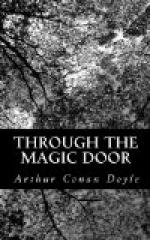I notice, in glancing over my rambling remarks, that I classed “Ivanhoe” as the second historical novel of the century. I dare say there are many who would give “Esmond” the first place, and I can quite understand their position, although it is not my own. I recognize the beauty of the style, the consistency of the character-drawing, the absolutely perfect Queen Anne atmosphere. There was never an historical novel written by a man who knew his period so thoroughly. But, great as these virtues are, they are not the essential in a novel. The essential in a novel is interest, though Addison unkindly remarked that the real essential was that the pastrycooks should never run short of paper. Now “Esmond” is, in my opinion, exceedingly interesting during the campaigns in the Lowlands, and when our Machiavelian hero, the Duke, comes in, and also whenever Lord Mohun shows his ill-omened face; but there are long stretches of the story which are heavy reading. A pre-eminently good novel must always advance and never mark time. “Ivanhoe” never halts for an instant, and that just makes its superiority as a novel over “Esmond,” though as a piece of literature I think the latter is the more perfect.
No, if I had three votes, I should plump them all for “The Cloister and the Hearth,” as being our greatest historical novel, and, indeed, as being our greatest novel of any sort. I think I may claim to have read most of the more famous foreign novels of last century, and (speaking only for myself and within the limits of my reading) I have been more impressed by that book of Reade’s and by Tolstoi’s “Peace and War” than by any others. They seem to me to stand at the very top of the century’s fiction. There is a certain resemblance in the two—the sense of space, the number of figures, the way in which characters drop in and drop out. The Englishman is the more romantic. The Russian is the more real and earnest. But they are both great.
Think of what Reade does in that one book. He takes the reader by the hand, and he leads him away into the Middle Ages, and not a conventional study-built Middle Age, but a period quivering with life, full of folk who are as human and real as a ’bus-load in Oxford Street. He takes him through Holland, he shows him the painters, the dykes, the life. He leads him down the long line of the Rhine, the spinal marrow of Mediaeval Europe. He shows him the dawn of printing, the beginnings of freedom, the life of the great mercantile cities of South Germany, the state of Italy, the artist-life of Rome, the monastic institutions on the eve of the Reformation. And all this between the covers of one book, so naturally introduced, too, and told with such vividness and spirit. Apart from the huge scope of it, the mere study of Gerard’s own nature, his rise, his fall, his regeneration, the whole pitiable tragedy at the end, make the book a great one. It contains, I think, a blending of knowledge with imagination, which makes




